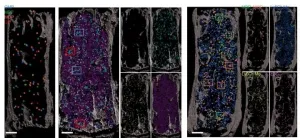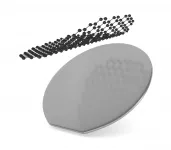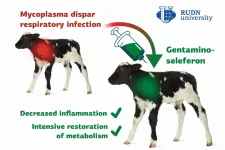(Press-News.org) CINCINNATI--Imagine a day when clinicians treating people with blood diseases such as leukemia or multiple myeloma can send in requests for laboratories to custom-produce specific types of blood cells to replace those affected by the disease.
That day became one step closer to reality with a new study led by experts at Cincinnati Children's that provides powerful new insights into how bone marrow tissue works.
The study, published Feb. 10, 2021 in Nature, was led by senior author Daniel Lucas, PhD, and first authors Jizhou Zhang, MD, and Qingqing Wu, PhD, from the Division of Experimental Hematology and Cancer Biology. Co-authors include a team of scientists from Cincinnati Children's and the University of Cincinnati, plus collaborators in Colorado, Texas and Michigan.
The team used a combination of cell-by-cell analysis techniques to build the first "atlas" of bone marrow tissue. The findings advance scientific understanding of how tiny blood vessels organize the bone marrow and regulate how blood gets produced.
"We finally have the tools to directly observe bone marrow cell differentiation. These results show that the bone marrow is a highly organized tissue and that this organization is provided by specific subsets of vessels," Lucas says. "This is telling us that the organization of the vasculature dictates blood production. If we determine how the vessels function we will be one step closer to controlling the production of specific blood cells at will."
A BLUEPRINT OF BLOOD CELL PRODUCTION IN SITU
With recent advances in genomic analysis technology, researchers at Cincinnati Children's and other major centers have been producing a growing library of "maps" that describe human tissue development in unprecedented detail. (Read more about the multicenter Pediatric Cell Atlas project.)
This study in Nature adds a thick reference book of bone marrow and blood cell development information to the virtual shelves.
Making this bone marrow atlas required the development of novel confocal imaging methods for unprecedented resolution of blood cells in the marrow.
Until now, tracing the lineage of cell types during stages of development required destroying the tissue. In this project the team developed ways to image and trace for the first-time unique progenitors within the larger mass of bone marrow cells--without destroying the tissue structure.
"Tracking these special cell clusters revealed new information about the structure of bone marrow," Lucas says, "including the insight that the bone marrow has a surprising degree of organization and that specific blood vessels support the production of unique blood cell types."
HOW CAN THIS DISCOVERY ADVANCE CARE?
It typically takes several years of further research to translate basic science discoveries into practical applications. One potential direction for this line of study could be to support future development of highly customized blood cell factories that would mimic bone marrow function in laboratory settings.
Such blood organoids could be used to produce populations of blood cells with specific genetic variations, which scientists could analyze to develop improved treatments for disease. For example, a controlled method of blood cell production would be useful to scientists studying the immune system and how bodies defend themselves against infection, Lucas says.
Eventually, blood organoids might become a form of treatment themselves by allowing clinicians to replace a patient's diseased cells with gene-edited healthy cells that face no risk of rejection. Having new understanding of how blood cells are produced in the bone marrow will help this effort.
"This certainly has implications for generating blood organoids," Lucas says. "The groups working on blood organoids have been trying to produce organoids that can maintain or expand stem cell production. Our data indicates that additional structures are needed to produce mature blood cells in a balanced manner."
NEXT STEPS
More study is needed to identify the molecular signals produced by the different blood vessels that regulate production of each type of blood cell. Knowing those signals will be a crucial step to regulating blood cell production.
Meanwhile, the research team plans to continue its work developing tools to image blood cell production, especially to expand imaging to earlier-stage progenitors.
"We want to be able to visualize every step in the production of the different types of blood cells," Lucas says.
INFORMATION:
ABOUT THIS RESEARCH
Funding for this study included grants from the National Heart Lung and Blood Institute (R01HL122661, R01HL136529); NIH/NCATS (U2CTR002818, NIH/NHLBI U24HL148865), and NIH/NIAID (U01AI150748); other NIH grants (R01AI120202, R01AI124657, DP1AI131080, AG045040, T32 AI118697, S10OD023410); and the US Department of Defense (W81XWH-20-1-0870 #CA191188).
Other funders include the Cincinnati Pediatric Cell Atlas Center, the HHMI Faculty Scholar's program, March of Dimes Ohio Collaborative for Prematurity Research, the Burroughs Wellcome Fund, and the Welch Foundation.
Imaging planets orbiting around nearby stars, which could potentially harbour life, has become a possibility thanks to the progress made in observational methods by an international team of astronomers. First candidate: Alpha Centauri, a system similar to ours, "only" 4.3 light years away. This study is the subject of a publication in the journal Nature Communications.
Efforts to obtain direct images of exoplanets - planets outside our solar system - have so far been hampered by technological limitations, which have led to a bias towards detecting planets much larger than Jupiter, around very young stars and far from the habitable zone, the area in which a planet may have liquid water on its surface, and thus ...
Researchers from the University of Seville's Nursing Department, with the collaboration of professionals from the ICU at Virgen Macarena University Hospital in Seville, have analysed the key factors in caring for critical COVID-19 patients during the first wave of the pandemic. Their study concludes that nursing care was impacted by fear and isolation, which made it difficult to maintain the human experience of health care.
The break down in the humanising trend of ICU care during this period was mainly the result of the isolation of COVID-19 patients. This, along with the personal protection equipment worn by staff to prevent becoming infected ...
10,000 km2 of ice disappeared in a blink of an eye from an ice sheet in the Storfjorden Through offshore Svalbard, a new study shows. This dramatic break off was preceded by quite a rapid melt of 2.5 kilometres of ice a year. This parallels the current melt rates in Antarctica and Greenland and worries the scientists behind the study.
"Our measurements of the ice retreat in Storfjorden Through show that the prevailing conditions to the great break off, match what we see in Antarctica and Greenland today. It is uncanny. There are new studies published almost weekly, that show that the retreat of current ice sheets is two to four km a year and that it's speeding up." Says CAGE-professor and first author Tine Lander Rasmussen.
Climatically unstable period
The last deglaciation, ...
Two-dimensional (2D) materials have a huge potential for providing devices with much smaller size and extended functionalities with respect to what can be achieved with today's silicon technologies. But to exploit this potential we must be able to integrate 2D materials into semiconductor manufacturing lines - a notoriously difficult step. A team of Graphene Flagship researchers in Sweden and Germany now reports a new method to make this work.
The technique, just published in Nature Communications by researchers from Graphene Flagship partners RWTH Aachen University, Universität der Bundeswehr ...
New research from Trinity College Dublin suggests that older adults can be more focused, less impeded by anxiety and less mentally restless than younger adults. The team at the Trinity College Institute of Neuroscience (TCIN) (today, Wednesday, 10th February, 2021) show that older adults appear to mitigate the negative aspects of cognitive decline by increasing motivation and adopting more efficient strategies to suspend the wandering mind when focus is required.
The study, published in the journal Psychology and Aging (American Psychological Association) is the first to adjudicate between competing theories of age-related ...
In recent years, three meta-analyses of clinical studies have come to the conclusion that vitamin D supplementation was associated with a reduction in the mortality rate from cancer of around 13 percent. Scientists at the German Cancer Research Center (DKFZ) have now transferred these results to the situation in Germany and calculated: If all Germans over the age of 50 were to take vitamin D supplements, up to 30,000 cancer deaths per year could possibly be avoided and more than 300,000 years of life could be gained - in addition, health care costs could be saved.
For several years now, scientists have been investigating the influence of an adequate supply of vitamin D on the ...
Overfishing, hunting and intensive agriculture and forestry can sometimes contribute to plants and animals becoming endangered. New research from Lund University in Sweden and University of Toronto can now show why this leads to entire populations becoming smaller in size, as well as reproducing earlier. The study is published in the journal PNAS.
Researchers from Lund and Toronto are behind the study conducted on five different species of damselflies. They have studied how different environmental factors affect when and at what size the damselflies begin to reproduce. In the study, the researchers also shed light on how overfishing off the coast ...
COLUMBUS, Ohio - The death of a vampire bat 19 days after giving birth presented scientists studying the animals in 2019 with an unexpected chance to observe a rare event: a female bat's adoption of an unrelated baby.
The researchers had captured common vampire bats in Panama as part of ongoing studies of the formation of cooperative relationships among strangers. The team used infrared surveillance cameras to observe six hours of vampire bat activity spaced over the span of each day.
Two unrelated and unfamiliar female bats were observed forming a social bond based on mutual grooming and food sharing that increased over time. The researchers had named them BD and Lilith.
Lilith ...
Respiratory tract diseases in young animals of the cattle are a big issue for world agriculture and food safety because a bacterium that causes them is resistant to most antibiotics. A team of veterinarians from RUDN University developed and tested a complex preparation called gentaminoseleferon that could help treat respiratory infection in calves. The results of the study were published in the Veterinary World journal.
Bacteria of the genus Mycoplasma cause many infectious diseases in animals, including atypical pneumonia, other respiratory tract conditions, reproductive pathologies, arthritis, keratoconjunctivitis, mastitis, and so on. The genus includes about 200 species of bacteria, and all of them ...
Every day, people die from simple infections even though they have been treated with antibiotics. This is because more and more bacteria have become resistant to the types of antibiotics that doctors can prescribe.
- It's a huge societal problem and a crisis that we must solve. For example, by developing new antibiotics that can defeat the resistant bacteria, says professor of chemistry at the Department of Physics, Chemistry and Pharmacy, University of Southern Denmark, Poul Nielsen.
Resistant bacteria are not only known from pig farms, where it is becoming increasingly difficult to keep the pigsties disease-free. Hospitals are also experiencing with increasing regularity that, for example, infectious diseases cannot be controlled in patients. Thus, ...




